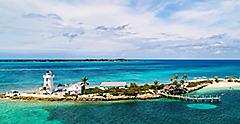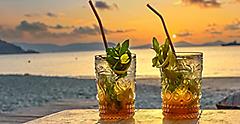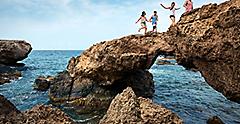Look beneath the surface, and you'll discover hundreds of sunken ships strewn throughout the Caribbean with hulls taken over by marine life. The original Caribbean shipwrecks date back to the 17th and 18th centuries — relics from the Golden Age of Piracy. Today, their wooden structures have been largely reclaimed by the sea. Other famous Caribbean shipwrecks include the surviving steel hulls of mighty warships, super yachts, humble tugboats and giant freighters that linger on the seabed, bound to be forgotten by all except the occasional curious diver.

What It's Like Diving Among Shipwrecks
It's eerie to see a sunken ship on the sea floor. On a clear day, rays of sunlight pierce the blue water like fishing line, wrapping around the shipwreck's hull as if to lure the ship back to where it belongs. But the sea has other plans. After a ship sinks in the Caribbean, it becomes a new habitat for aquatic life. Coral frags attach themselves to the hull, and fish take shelter in its shadows.
As a scuba diver and free diver with hundreds of dives under my fins, I've learned that diving among shipwrecks with a tank and without can offer wildly different perspectives of the same ship. No matter how you do it, exploring at a wreck dive site feels like a humbling journey to a bygone era.

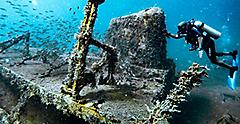
Thanks to a tank of air, scuba divers have time to examine the finer details of the ship, often penetrating its interior. It's a peek into the past, with clues of what life onboard was like hidden around every corner. The weightlessness as you move through the vessel (taking care to squeeze through hatches and windows) feels almost otherworldly. Dive with scuba gear to linger and admire the various corals, anemones and critters tucked between the crags of the ship reef. You'll feel like you're examining the ship through the lens of a magnifying glass.
Free divers only explore shipwrecks one breath at a time, taking a break at the water's surface in between each dive. With no loud breathing apparatus or bubbles to scare marine life away, sea creatures often come much closer to free divers than scuba divers. If visibility is good, you can often see the full scale of the ship from the surface. Because free divers must be mindful of their body at every moment, diving at a shipwreck is as much of an inner journey as it is an outer one.
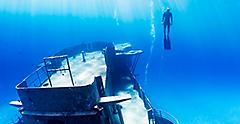
Famous Sunken Ships In The Caribbean
Dive The Gargantuan Freighter Ss Stavronikita, Barbados
Explore Shipwrecks Galore At Carlisle Bay, Barbados

Beginner divers (both scuba and free divers) can hop from one wreck to the next at Carlisle Bay. Here, you'll find many famous sunken ships, such as the Berwyn, Cornwallis, Bajan Queen, Fox, Eilon and C-Trek. The Berwyn, a French tugboat, sunk over a century ago after coming under fire during World War I. Rumors claim the crew onboard wrecked the boat intentionally, fleeing the ship and taking refuge in the pubs of Barbados. It's customary to toast to the former crewmates with a rum punch after your dive.
For free divers and snorkelers, there are few better shipwrecks in the Caribbean to discover than the Bajan Queen. Also in Carlisle Bay, this 120-foot tugboat was sunk in 2002 and has yet to fully be overtaken by the elements. Bajan Queen also happens to be one of the most accessible shipwrecks in the Caribbean, starting just a few feet under the ocean's surface. Sea turtles, rays and reef sharks often cruise around its hull, and experienced divers can venture to its engine room.
Snorkel And Dive The Ss Sapona, Bahamas
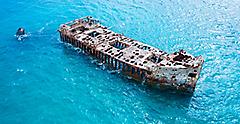
The SS Sapona was once a powerful 282-foot cargo steamer that cruised the waters of the Caribbean during World War I. In 1926, a severe hurricane caused the ship to veer off course and run aground near Bimini, where it rests to date. Now, it's one of the most facinating shipwrecks in the Bahamas.
Above water, the creaking, rusty hull of SS Sapona looks like a lifeless skeleton of its former self. But put your mask on and peer underneath the water to discover a place that's teeming with sea life. Because the wreck dive starts at the water's surface, it's a perfect place for free divers and snorkelers to warm up before going deeper. Scuba divers can scour the bottom in search of frog fish, nudibranchs, starfish and crabs. Reef sharks, grouper, sea turtles and rays of various types are also often spotted checking out the wreck.
Geek Out At The Ss Kittiwake, Cayman Islands

Stick To Your Guns At Mv Captain Keith Tibbetts, Cayman Islands

The MV Captain Keith Tibbetts is one of the most peculiar shipwrecks in the Caribbean. This 330-foot frigate was built by the Soviet Union in 1984 to be used by the Cuban navy. In 1996, it was sold to the Cayman Islands, which sunk the ship between the islands of Little Cayman and Cayman Brac. The wreck was pummeled by a hurricane in the early 2000s, giving it a more dramatic appearance than you might expect from a purposefully sunken ship — but this only adds to its appeal. Strong swimmers can reach the wreck on a calm day from the north side of Cayman Brac, though there are regular boat trips departing from the islands.
While this shipwreck was seemingly unwanted by its former owners, it's become a beloved home to the groupers, scorpionfish, corals, sponges, reef fish and rays who have taken a liking to the security that the ship's turret guns provide. Experienced divers can penetrate the wreck via large entry points in its sides.
Admire The Ghost Ship Of Antilla, Aruba
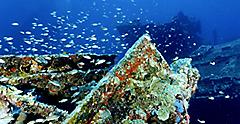
At 400 feet long, the Antilla is thought to be one of the largest and most famous Caribbean shipwrecks. It's often referred to as the Ghost Ship by the dive community thanks to its odd demise. It was built in 1939 in Germany for one of the largest German shipping companies at the time. In 1940, the Antilla was anchored off Aruba, then a Dutch colony. Over on Europe's mainland, Germany invaded the Netherlands, and the Antilla suddenly found itself in hot water. Dutch mariners attempted to board the Antilla, though the German captain refused to let them aboard. Instead, the captain ordered for all valves to be open and then set fire to his own ship. Crew members onboard abandoned ship and were promptly arrested by the Dutch. No lives were lost in this shipwreck fiasco.
Today, the Antilla is one of the most scenic underwater shipwrecks. A few parts of it teeter just above the ocean's surface, serving as a haven for seafaring birds. From the water, you can watch as pelicans dive for fish, embarking on a high-speed underwater chase. On the wreck, you'll find an array of soft and hard corals, carpets of anemones, crustaceans, moray eels and octopus. Reef sharks regularly cruise by, too.
What To Know Before You Go
No matter if you're a seasoned free diver or a snorkeler who feels best while wearing a life vest, there are shipwrecks for you to enjoy. Some have harrowed histories and sit hundreds of feet under the sea, while others were sunk as artificial reefs and are found nearer to the ocean's surface.
Nearly every port of call in the Caribbean is home to a scuba diving center, where you can take a range of courses, including one-day discovery sessions and dive instructor training. Likewise, free diving is becoming popular throughout the archipelago, with free diving schools on Bonaire, Belize, Roatán, the Bahamas and the Cayman Islands. Best of all, many dive centers conduct their dives at one of the nearby wreck sites — a win for anyone who enjoys a bit of culture with their coursework.
When you're looking for a shipwreck to dive, depth is usually the most important factor. Choose a shipwreck that is well within your diving limits, so you can venture out without worrying about whether you'll run out of air. Diving with a trusted guide will help you discover nuances of the wreck that you might not be able to find on your own.
Get Royal Deals, Sign Up Today

Getting There
Explore Our Most Affordable Itineraries
Ready to dive these shipwrecks for yourself? Set off on a cruise to the Caribbean onboard Icon of the Seas℠.



